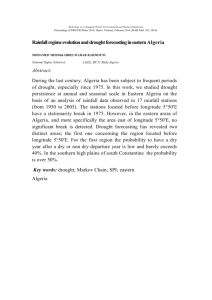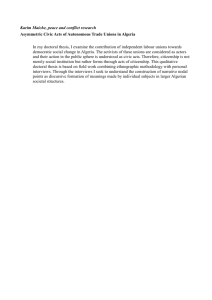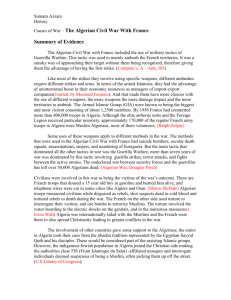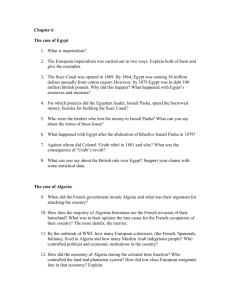Journal of Applied Finance & Banking, vol. 3, no. 5,... ISSN: 1792-6580 (print version), 1792-6599 (online)
advertisement
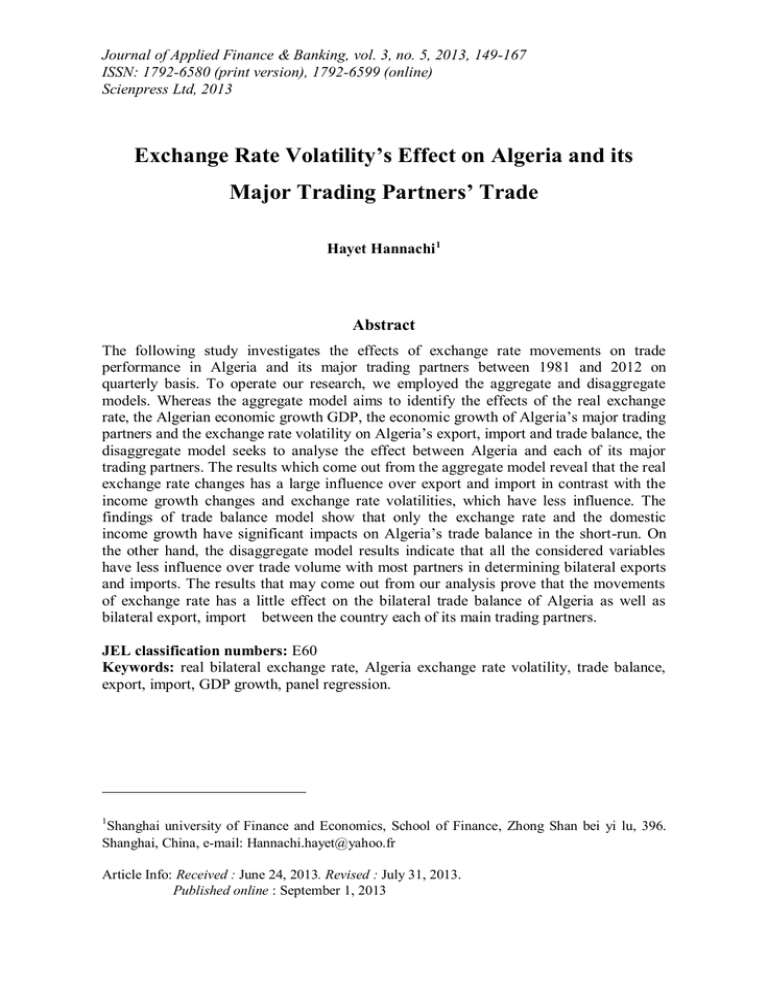
Journal of Applied Finance & Banking, vol. 3, no. 5, 2013, 149-167 ISSN: 1792-6580 (print version), 1792-6599 (online) Scienpress Ltd, 2013 Exchange Rate Volatility’s Effect on Algeria and its Major Trading Partners’ Trade Hayet Hannachi1 Abstract The following study investigates the effects of exchange rate movements on trade performance in Algeria and its major trading partners between 1981 and 2012 on quarterly basis. To operate our research, we employed the aggregate and disaggregate models. Whereas the aggregate model aims to identify the effects of the real exchange rate, the Algerian economic growth GDP, the economic growth of Algeria‟s major trading partners and the exchange rate volatility on Algeria‟s export, import and trade balance, the disaggregate model seeks to analyse the effect between Algeria and each of its major trading partners. The results which come out from the aggregate model reveal that the real exchange rate changes has a large influence over export and import in contrast with the income growth changes and exchange rate volatilities, which have less influence. The findings of trade balance model show that only the exchange rate and the domestic income growth have significant impacts on Algeria‟s trade balance in the short-run. On the other hand, the disaggregate model results indicate that all the considered variables have less influence over trade volume with most partners in determining bilateral exports and imports. The results that may come out from our analysis prove that the movements of exchange rate has a little effect on the bilateral trade balance of Algeria as well as bilateral export, import between the country each of its main trading partners. JEL classification numbers: E60 Keywords: real bilateral exchange rate, Algeria exchange rate volatility, trade balance, export, import, GDP growth, panel regression. 1 Shanghai university of Finance and Economics, School of Finance, Zhong Shan bei yi lu, 396. Shanghai, China, e-mail: Hannachi.hayet@yahoo.fr Article Info: Received : June 24, 2013. Revised : July 31, 2013. Published online : September 1, 2013 150 1 Hayet Hannachi Introduction Many researchers and scholars from a wide range of nationalities have been increasingly interested in the relationship between exchange rate movements and their influence on trade performance. This topic is currently one of the „crucial topics‟ in the field of trade and finance. However, the focus of the existing studies on the developed countries and the lack of consensus among researchers about the impact of exchange rate volatility on the growth of international trade performance raise the question of whether or not the already found results could be applied to the developing countries such as Algeria. It is worth noting that Algeria –among a large number of developing countries has witnessed a rapid economic growth in the recent decades; there is almost certainly more adopted short and long term plans for further development than many other developing countries. Still, very few studies have investigated the exchange rate volatility impacts on Algeria‟s trade performance, which makes further academic inquiry into this area necessary. 2 Literature Review With the increase in research on trade performance, many empirical studies whose interests extend to this field have examined the relationship between exchange rate movements and trade performance. In the last decades, hundreds of research papers have considered the impact of exchange rate movement on trade flows from different perspectives. A review of analyses has shown that several approaches have been adopted and different results have been yielded. In their studies on trade balance, Isaac Bentum-Ennin (2008) and Bahmani-Oskooee (2001) established linkage between real depreciation and trade balance, their results support the existence of favorable long-term effects of real depreciation on trade balance. In an investigation on 46 middle income and emerging market countries between 1980 and 2005, Mark (2006) provided evidence that any country‟s trade balance depends significantly on the market structure of its exports. Conversely, the results obtained from Bahmani- Oskooee and Kovyaryalova‟s (2008) and Bahmani-Oskooe and Mitra‟s (2008) studies proved to be conflicting, their analyses of the impact of exchange rate uncertainty on trade flows with reference to commodity trade between two countries show that exchange rate uncertainty has rather more short-run effects than long-run effects. According to the investigation conducted by Akhter and Hilton (1984) on the relationship between the exchange rate movement and bilateral trade, the exchange rate volatility has a negative impact on bilateral trade between West Germany and the United States. However, Gotur (1985) disapproved Akhter and Hilton‟s (1984) findings after he improved the sample period and the measures of exchange rate risks, which made his research compatible with the 1984 IMF study. The influence of exchange rate volatility on the real imports of the United Kingdom from Canada, Japan and New Zealand during the period lasting from 1980 to 2003 was examined by Choudhry (2008). His analysis indicates a significant effect of the exchange rate volatility on the real imports. In contrast, several full-length studies proved the negative relationship between international trade and exchange rate volatility. For example, Olimov and Sirajiddinov (2008) found that exchange rate volatility has a negative impact on both the trade outflows and inflows of Uzbekistan. Similarly, the studies of Gagnon (1993), Chowdhury Exchange Rate Volatility’s Effect on Algeria 151 (1993), Arize (1995, 1998) and Arize et al (2000) demonstrate that exchange rate volatility leads to a reduction in international trade flows. In another study conducted on four East Asian countries (Hong Kong, South Korea, Singapore, and Thailand) Baak, Mahmood, and Vixathep (2002) inferred that exchange rate volatility has negative impacts on exports in both the short and long-term Periods. Further analyses, which have explored the relationship between the exchange rate and trade performance indicate a positive influence of exchange rate on international trade. Sercu and Vanhulle (1992) Sercu and Uppal (2003), Franke (1991), Viaene and deVries (1992), McKenzie and Brooks (1997), Doyle (2001), and Choudhry (2005) provided arguments that variability in an exchange rate can stimulate bilateral trade. By employing both theoretical and empirical models, they showed that trade might benefit from exchange rate volatility From the above description and discussion of the existing literature on the issue of the relationship between exchange rate and trade performance, it is safe to argue that there is a non-determined relationship between international trade and the volatility exchange rate. Moreover, seldom have efforts been made to draw a linkage between exchange rate and trade performance in the developing countries .In this research paper, we shall try to avoid the pitfalls of previous studies on this issue by emphasizing the connectedness of Algeria‟s trade performance with exchange rate volatility, bilateral real exchange rate and the change in the country‟s income growth and that of its major trading partners. 3 The Evaluation of Algeria’s Exchange Rate Behaviour From 1974 to 1994, Algeria had a fixed exchange rate system that was determined by pegging the Algerian Dinar (DZD) to a basket of currencies, adjusted from time to time. Starting from 1994, in order to ensure the stability of the real effective exchange rate (REER), the Bank of Algeria adopted a managed floating exchange rate system of the Dinar against the currencies of the country‟s major trading partners, through daily fixing sessions that included six commercial banks. The adoption of a managed floating exchange rate system, however, had some effects; it had caused an account surplus and a gradual devaluation of the Dinar against its major trading currencies. The gradual exchange rate movements of the Algerian Dinar against the currencies of the country‟s major trading partners is shown in Appendix A, it depicts some volatility from 1981 to 1990. During the period lasting from 1991 to 2012, the Algerian authorities maintained a policy that resulted in a trend of depreciation in the DZD exchange rate. This depreciation policy was accompanied by a recovery of hydrocarbon prices and an increase in public expenditure. However, In spite of the Dinar depreciation, still some appreciation was recorded within the last two decades. On December 12, 2012, the average buying and selling rates of the U.S. dollar was US$1=DZD78.21, equivalent to SDR1=DZD120.15. To sum up, the trend of depreciation in exchange rate led to significant changes in terms of trade regulations, the inflation differentials with trading partners and the increase of productivity gap vis-a-vis the trading partners. 152 4 Hayet Hannachi Algeria’s Trade Flows and the Country’s Major Trading Partners Due to its economic growth, Algeria succeeded to reserve a seat as a member of the United Nations, African Union and OPEC (Organization of Petroleum Exporting Countries). The fact that the country has the seventh-largest reserves of natural gas, the fourth-largest exports of natural gas, and the tenth-largest oil exports in the world reveals that the Algerian economy is largely dependent on the hydrocarbon sector and explains why the country‟s trade balance is frequently positive. To put that in numbers, in 2007, Algeria had an export product concentration ratio of 60.6 and a positive trade surplus, which was mainly due to Hydrocarbons, which formed 98% of total exports. As a result, from 1992 to 2012, Algeria‟s Trade Balance averaged US$6.57 billion, reaching an all-time high of US$34.06 billion in December 2006 and a record low of -US$2.34 Billion in June of 2009. In 2012, the country‟s imports totalled US$46.80 billion against US$47.24 billion in 2011, in front of the exports, which hit US$73.98 billion (2.96%of which were non-oil exports US$2.18 billion) against US$73.48 billion in 2011 and consequently the trade balance recorded a surplus of US$27.18 billion against US$26.24 in 2011 due to the increase in the oil prices and the slight decrease in the imports of consumer non-food materials. Concerning Algeria‟s main export partners in 2012, the United States comes first with (US$11.94bn), followed by Italy (US$11.67bn), Spain (US$7.57bn), France (US$6.60bn) and Canada (US$5.48bn), as for the country‟s main suppliers, France is ranked first with over US$6bn, then China (US$5.88bn), Italy (US$4.34bn), Spain (US$4.09bn) and Germany (US$2.57bn). (See Appendix B) Algeria has a strong trading relationship with the United States. With a trade volume, going from US$3.3billion in 2002 to over US$22billion in 2008, Algeria is considered as the U.S‟ biggest trading partner in North Africa and its second-biggest trading partner in Africa and the Arabic world as a whole. Algeria also enjoys a good reciprocal trading relationship with the European Union, while the country is ranked as the European Union's third largest energy supplier in 2011 with a value of US $ 36.18 billion, the European Union absorbs almost half of Algerian international trade. Its exports to Algeria are mostly machinery stuff, telecommunication equipment, agricultural products, iron, steel and chemicals. Algeria‟s main trading partners in the EU are France, Germany, Italy, UK, Spain and Netherlands. Apart from the European Union and the United States, Algeria is a trading partner of Canada and Japan. In 2007, the Algerian exports to Canada reached US$5.1billion, while the Algerian imports from Canada did not pass US$505million. 5 Empirical Analysis 5.1 Methodology Algeria‟s dependence on hydrocarbons in its exports, the high volumes of its imports and its managed floating exchange rate system are issues too tempting to conduct an empirical study which investigates the effects of exchange rate movements on bilateral trade flows between Algeria and its top 8 trading partners (Canada, France, Germany, Italy, Japan, Nether land, Spain, USA). It is also our intention in this paper to explore whether or not the exchange rate volatility have any significant impact on bilateral trade balance. To implement our analysis, we based our study on the aggregate and disaggregate trade data Exchange Rate Volatility’s Effect on Algeria 153 between Algeria and its major trading partners by employing a panel regression model and in order to determine the order of integration, we used Augmented Dickey Fuller (ADF) test with and without trend. Based on aggregate trade data for both export and import functions between Algeria and its major trading partners, we built the bellow regression model to examine the impact of exchange rate movements ∆ TRt, i = β1 + β2 ∆REt-1 + β3 ∆Yt + β4 Volt + ε t Export Import (+) (- ) (+) (+) (5.1) (-) (-) Each of the variables in the above equation has its equivalent. Whereas ∆TR is the quarterly change in Algeria‟s aggregate export/import, ∆RE is the quarterly change of Algeria‟s real exchange rate; it depicts the depreciation of Algerian Dinar due to the increase in real exchange rate. ∆Y, Vol, and εt stand for the quarterly change in real GDP growth of the importing country, the measure of exchange rate volatility of the real exchange rate, and the disturbance term respectively. Concerning Algeria‟s export and import functions, we expect β2 to be positive since real depreciation of Algerian Dinar is believed to raise Algeria‟s exports to its major trading partners, we also estimate β2 to be negative in the import model since the depreciation of DZD lessens Algeria‟s imports from its trading partners. Since the increase in Algeria‟s trading partners‟ income is expected to raise their imports from Algeria, so β3 must necessarily be positive in both Algerian exports and imports models, for β4 is expected to be negative in case the Algerian exports and imports are deterred by exchange rate variability. In order to explore the impact of exchange rate changes and other variables on Algeria‟s bilateral trade balance with its major partners, we developed the following trade balance regression model. ∆ TB t, i = λ1 +λ 2 ∆REt-1 +λ3 ∆YAlg, t + λ4 ∆Y t + λ5 Volt + ε t (+) (-) (+) (+/-) (5.2) The variables in the second equation are the same as in the first one except ∆TB and ∆YAlg. Whereas ∆TB is the quarterly change in Algeria‟s bilateral trade balance (generally defined as the difference between the change in Algeria‟s total exports (∆EX) to its trading partners and the change in Algeria‟s total imports (∆IM) from its trading partners), ∆YAlg is the quarterly change in domestic income. In the context of the second model, the depreciation of the exchange rate raises exports, reduces imports and leads to improve the trade balance, which makes λ 2 positive. The same for λ4, which is expected to be positive because an increase in foreign income might stimulate the country‟s exports leading to improvement of the trade balance. λ 3, on the other hand is believed to be negative due to the positive relationship between imports and domestic income. Since higher exchange rate volatility hampers both exports and imports, λ5, remains unclear, which will harden the process of determining the kind of effect. The previous studies helped to investigate the relationship between the exchange rate changes and trade flows on a wide rage. Yet, there are limits as well in this regard since most of the analyses are based mainly on aggregate trade data; which makes them suffer 154 Hayet Hannachi from the aggregation bias. With this in mind the present study tries to make modest effort in this area, emphasizing not only on the effects of exchange rate changes on aggregate trade flows, but also on the effects of exchange rate changes on disaggregate trade flows (for every partner). The focus on bilateral disaggregate data set helps to identify partner-specific characteristics and also explains how and why the partners are affected by exchange rate volatility. Based on equation (5.1) for both export and import functions and (5.2) for trade balance function, β1 and λ1 alternatively are assumed to be constant (common coefficients) over time (t), the slope coefficients are also expected to be constant for all partners in aggregated trade flows (common coefficients) but different in disaggregated trade flows (cross-section specific coefficients). 5.2 Data Source To conduct our study, we arranged the data according to a quarterly time series lasting from 1981:1 to 2012:4. The time series data for Algeria and its major trading partners (Canada, France, Germany, Italy, Japan, Nether land, Spain, USA) are mainly obtained from the Central Bank reports; other data set is provided by the International Financial Statistics of the IMF (CD-ROM), the Direction of Trade Statistics of the IMF (CD-ROM) and the World Bank‟s World Development Indictors. The Data consists of observed values of aggregate and bilateral exports, aggregate and bilateral imports, real bilateral exchange rate and the real gross domestic product growth. 5.3 Empirical Results 5.3.1 Unit Root test The results of (ADF) test presented in Appendix C show that most variables are non-stationary at level I. Consequently, to reach stationary, we differenced the data as a result all variables for the 8 countries and Algeria are significant at 1% level in the first differences 5.3.2 Aggregate Model As mentioned above, we have used time series aggregate trade data in order to estimate the regression models represented in equations (5.1) and (5.2). The bellow tables (1 and 2) resume the results of our analysis. First, most of the coefficients in table 2, for both export/import models are statistically significant, they prove all the above expected signs, except for the real exchange rate changes which appear to have an opposite expected sign in the import model. Second, we can consider Algeria‟s imports as Giffen products and say that the income effect is verified in Algeria‟s economy case. The fact that the imports of Algeria increase whenever the exchange rate depreciates can give us an insight about the nature of the necessary products Algeria is importing: Algeria is still importing as much as it was before the national currency depreciates. Despite the increase in foreign income, no significant change is recorded concerning Algeria‟ exports, this seems to be evident if we take into account the supply restriction imposed by the OPEC (Organization of the Petroleum Exportation Countries) and the huge gap between the economic sizes of Algeria and its major trading partners which leads Algeria‟s export to be less influenced by the major trading demand than Algeria‟s Exchange Rate Volatility’s Effect on Algeria 155 import being influenced by its own demand. We also take into consideration the time adjustment for variables (the short run). Table 2: Impact of Exchange Rate Movements on Algeria‟s Aggregate Exports and Imports ` Export Model Import Model ∆ RE t-1 7.337896** ∆ RE t-1 9.874282*** (3.095566) ∆ Yt Volt Constant (2.038778) 0.000178 (0.004361) -0.718145** (0.291438) ∆ YAlg,t 15.53199*** Constant Volt 2.331707** (1.028114) -5.075711 (3.106942) -18.05447*** (3.947631) (1.65427) 2 2 Adjusted R 0.788469 Adjusted R 0.693411 Observations 912 Observations 912 Note: Standard errors are given in parenthesis. ***, ** and * indicate the significance of coefficients at 1%, 5% and 10% respectively Our findings in table 2 tend to be identical with the results of previous works on the impact of exchange rate volatility on trade. From one hand, they suggest that in case of export model, the exchange rate volatility has a negative and significant effect; the negative volatility term indicates that if variability in exchange rate increases, risk adverse traders favour domestic market than the international one in the short run . On the other hand, although, the imports are negatively affected by exchange rate volatility, statistically this is proved to be insignificant because Algeria‟s imports are necessary goods that cannot be stopped or substituted by local products. The third table resumes the results of the aggregate trade balance model (equation (5.2)). The overall results are consistent with the previous findings from the analysis of the export and import functions. We find that the exchange rate changes have significant effects on trade balance in the short run. Change in Algeria‟s income has a negative impact on trade balance, while change in Algeria‟s major trading partners income is statistically insignificant implying that the higher income in those countries doesn‟t improve the trade balance in the short run. Further, the results show that the exchange rate volatility is negatively related to trade balance even though, the effect is statistically insignificant. 156 Hayet Hannachi Table 3: Impacts of Exchange Rate Movements on Algeria Trade Balance Aggregate Trade Balance Model ∆ RE t-1 1.858726** (0.847856) ∆Yt 0.000846 (0.004033) ∆ YAlg,t -0.191066*** (0.041067) Volt -0.882871 (0.966704) Constant -1.476205*** (0.059449) Adjusted R2 0.240766 Observations 912 Note: Standard errors are given in parenthesis. ***, ** and * indicate the significance of coefficients at 1%, 5% and 10% respectively 5.3.3 Disaggregate Model In the first part of our analysis, we dealt with the impact of exchange rate volatility on aggregate exports, imports and trade balance data. Our interest in the present section is to test the impact on disaggregate trade balance by having a close look to each partner. The bellow tables (4,5 and 6) resume the results of bilateral export, import and the bilateral trade balance models to estimate the panel regression models in equations (5.1 and 5.2). The results indicate that the effects on Algeria‟s bilateral export, import and trade balance are not always highly significant and almost all the coefficients are compatible with the expectations but statistically are not all significant. In the case of export and import models the intercept is highly significant, but Adjusted R2 is not that highly significant. This is due to the short run measure we are working according to and the insufficient time for exports and imports to be adjusted, in addition to the intervention of the Algerian government in manipulating the exchange rate. Whereas the results presented in table 4 show that the depreciation of the Algerian currency against the country‟s major trading partners‟ currencies has positive impact on Algeria‟s exports and is significant at the 5% level with Canada, Italy, Nether land and USA, and at 10% with France, the results in Table 5 indicate that the real bilateral exchange rate changes carry two different signs; a negative sign as we expected with Germany at 1% and with Japan at 5% level which indicates that Algeria‟s exports from these countries are not necessary goods (alimentary goods) but luxury ones , and a positive sign with France (the main supplier of Algeria) and Spain but it is insignificant. The positive sign indicates that depreciation of the Algerian currency against the Exchange Rate Volatility’s Effect on Algeria 157 above-mentioned countries‟ currencies does not discourage Algeria‟s imports from France and Spain in the short run. The results of the final table are consistent with our expectations; they indicate that the depreciation in the Dinar has a positive sign on Algeria‟s trade balance and all the coefficients of Algeria‟s major trading partners are statistically significant except for Germany and Japan, which are insignificant. These results also show that the bilateral exchange rate plays an important role in the trade between Algeria and its trading partners and the trade balance seems to benefit from the depreciation of the Algerian currency in the short run. According to the results of table 4, we deduce that in the case of Algeria‟s bilateral export, the change in Algeria‟s major trading partners‟ income carries the expected positive sign and it is significant at 1% level with the US because it is the first importing country from Algeria, and at 5% level for both France and Spain and only 10% for Canada. An increase in Algeria‟s trading partner‟s income is expected to raise its imports from Algeria and consequently improves the bilateral trade balance that we notice in table 6 (positive sign). It is worth noting that even in the case of Algeria‟s bilateral import model, change in the domestic income growth carries an expected positive sign and the coefficient is highly significant at 1% level for France and Germany and at 5% level for Italy, Spain and insignificant for the rest partners as it is recorded in table 5. The increase in Algeria‟s income growth raises Algeria‟s imports from her major trading partners and this influences the trade balance negatively as we see in table 6 (the negative sign). The results for exchange rate volatility in export, import and trade balance models always show a negative sign which means that the exchange rate volatility of Algeria‟s currency against the country‟s major trading partner‟s currencies has adverse effects on trade (discourages trade) in the short run, but it is significant only with few. In both the export and import models, the exchange rate volatility is significant with the first importer from Algeria (USA) at 1% level also with France (the first exporter to Algeria) at 5% level, and at 10% level with Germany and Japan. In the bilateral trade, it appears that any risk introduced by the exchange rate fluctuations has unfavourable effects and it is significant at 1% level with the USA, 5% level with Canada and at 10% level with France. 158 Hayet Hannachi Table 4: Impact of Exchange Rate Movements on Algeria‟s Bilateral Export Model (Panel Estimation) variable Constant ∆RE t-1 ∆Yt Volt Canada France Germany Italy Japan Nether land Spain USA -28.15173 ** 1.523885** 1.562399 * -4.819564 (11.17592) (0.732336) (0.872343) (0.174567) -28.15173 ** 0.939478* 9.121617** -2.162614 (11.17592) (0.481969) (3.936222) (3.133436) -28.15173 ** 4.705760 1.138565 0.597274 (11.17592) (49.94733) (18.65689) (1.102036) -28.15173 ** 1.119850** 2.015532 -0.936107 (11.17592) (0.477986) (2.682561) (1.102106) -28.15173 ** 2.255085 0.181986 3.622663 (11.17592) (0.501624) (0.246359) (5.256656) -28.15173 ** 0.9446881** 7.551058 0.404889 (11.17592) (0.473255) (7.797913) (1.124586) -28.15173 ** 0.160307 1.138908** -0.227415 (11.17592) (0.481705) (0.474663) (1.138535) -28.15173 ** 1.320093** 1.166526*** -0.171635*** (11.17592) (0.648412) (0.1481869) ( (0.0443215) Adjusted R2 Observation Number of partners 0.595860 920 8 Note: Standard errors are given in parenthesis. ***, ** and * indicate the significance of coefficients at 1%, 5% and 10% respectively Exchange Rate Volatility’s Effect on Algeria 159 Table 5: Impact of Exchange Rate Movements on Algeria Bilateral Import Model (Panel Estimation) variable Constant ∆RE t-1 ∆ YAlg, t Volt Canada France Germany Italy Japan Nether land Spain USA 9.882295*** -2.449663** 2.396653 -1.150739 (0.475767) (1.243344) (2.651863) (15.30903) 9.882295*** 1.959508 2.340552*** -3.421752** (0.475767) (1.694608) (0.645526) (1.527822) 9.882295*** -9.589301*** 4.858871*** -8.404723* (0.475767) (1.687957) (0.875450) (4.490550) 9.882295*** - 2.424214 5.911785** -6.869546 (0.475767) (1.687957) (2.675601) (6.490550) 9.882295*** -2.881710** 3.035507 -8.747174* (0.475767) (1.668534) (2.578221) (4.820873) 9.882295*** -1.814683 0.329000 2.125987 (0.475767) (16.87957) (2.675601) (6.490550) 9.882295*** 1.072796 6.362961** 2.189028 (0.475767) (0.787957) (2.675601) (1.490550) 9.882295*** -7.474507 2.587694 -0.798194 (0.475767) (23.22722) (2.595079) (1.099345) Adjusted R2 0.642650 Observation 920 Number of partners 8 Note: Standard errors are given in parenthesis. ***, ** and * indicate the significance of coefficients at 1%, 5% and 10% respectively 160 Hayet Hannachi Table 6: Impacts of Exchange Rate Movements on Algeria‟s Bilateral Trade Balance ∆Yt variable ∆RE ∆Y Volt Constant t-1 Canada France -31.84168*** 2.591614** 2.562944* (11.84372) (1.175898) (1.496515) -31.84168*** 5.338771* (11.84372) -0.013325 -4.433710** (1.946599) 7.702755 (0.115055) -1.190128*** (2.726817) (7.020340) (0.119012) (3.027382) 0.299603 -0.102865 -0.074008 -0.591024 (11.84372) (8.009926) (3.056694) (0.109590) (1.782576) -31.84168*** 13.86839* -0.632003 (11.84372) (7.673306) (4.500264) (0.112202) (1.781791) -31.84168*** 9.770243 0.3 12434 0.053307 7.405319 (11.84372) (11.42114) (1.039821) (0.106381) (8.448542) -31.84168*** 16.05000** -0.117722 0.415740 (11.84372) (7.608561) (13.28040) (0.113908) (1.809137) -31.84168*** 9.997298* 7.703153 -0.252123** -0.936549 (11.84372) (6.023899) (9.138652) (0.127967) (1.827625) -31.84168*** 12.68692*** 1.973088*** -0.057208 -28.08340*** (11.84372) (4.034023) (0.265213) (7.120764) Germany -31.84168*** Italy Japan Nether land Spain USA Alg, t Adjusted R2 Observations 10.24983 -0.458211*** (0.121468) -5.031668* -0.405504 0. 673810 912 Number of partners 8 Note: Standard errors are given in parenthesis. ***, ** and * indicate the significance of coefficients at 1%, 5% and 10% respectively 6 Conclusion & Recommendation Our research is an empirical study that has examined empirically the impact of exchange rate movements on the trade flows between Algeria and eight of its major trading partners both on aggregated and disaggregated trade flows. We used the real bilateral exchange rate change, income change and exchange rate volatility as our variables. Based on the aggregate model, a depreciation of the Algerian currency is proved to have a positive significant effect on Algeria‟s exports and imports, which can be explained by the theory of Marshall-Lerner of inelastic goods that aren‟t affected by the depreciation of Algerian Dinar. On the other hand, the exchange rate volatility has negative effects on exports and Exchange Rate Volatility’s Effect on Algeria 161 Algeria‟s income growth triggers a higher demand for imports while the foreign income growth doesn‟t increase Algeria‟s trading partners‟ demands for Algerian products and this is mainly due to the difference in the relative importance of each trade partner to the other. We also noticed that the panel estimation results of the disaggregate model indicates that the exchange rate changes influence bilateral trade. The depreciation of the Algerian Dinar has positive effects on Algeria‟s exports to all its bilateral partners and negative effects on Algeria‟s bilateral imports from them except for France and Spain where the effects are positive. However, the bilateral exchange rate was not enough in explaining all the changes in the bilateral trade for Algeria. The bilateral estimation also shows that income changes in some major trading partners do affect trade, but not in the case of the aggregate model which makes the disaggregated bilateral trade data helpful in providing useful insights about Algerian trade. Concerning the exchange rate volatility, no clear effect was noticed except for USA, Canada and France, which witnessed an adverse relationship. Therefore, we are led to conclude that exchange rate movements do not have a large significant effect on Algeria‟s trade flows. The volatility of Algerian currency against the country‟s major trading partner‟s currencies used in this study does not depict the reality of Algerian economy because of two reasons: the first reason is that Algeria‟s exports are dominated by hydrocarbons products and the exportation procedures are conducted either in US dollar or the euro in case of dealing with the euro zone. This means that the DZD is not directly involved in the international trade process. The second reason has to do with the purchasing power of Algeria, which is more vulnerable to USD movements rather than those of DZD. Actually, these two points reflect the importance of petrodollar in the Algerian economy. Therefore, the use of the American dollar or Euro as proxy of the currency movement seems to be more practical for further studies in this regard. The Analysis provided in this study unveils the vulnerable structure of Algerian imports and exports , whereas the exports are largely composed of hydrocarbon products with no place for proliferated components and diversified markets, the Algerian imports are crucial and necessary products which reveals the high dependency of the country‟s economy on external supply. This trade balance structure needs to be revised and requires a separated analysis, which might lead to divert avenues of thought. References [1] [2] [3] [4] [5] Akhtar, M.A. and Spence-Hilton, “Effects of Exchange Rate Uncertainty on German and U.S. Trade”, Federal Reserve Bank of New York Quarterly Review, Spring, (1984), 7-16. Arize, A., “The effects of exchange-rate volatility on USA Exports: an empirical investigation”, Southern Econ Journal, 62, (1995), 34–43. Arize, A., “The effects of exchange-rate volatility on USA imports: an empirical investigation”, International Econ Journal, 12, (1998), 31–40. Arize, A., Thomas O, Slottje D., “Exchange-Rate volatility and foreign trade: evidence from thirteen LDC‟s”, Journal of Business & Economic Statistics, 18, (2000), 10–17. Baak, S., Al-Mahmood, A., and Vixathep, S., “Exchange Rate Volatility and Exports from East Asian Countires to Japan and U.S.,” (Manuscript). University of Japan, (2002). 162 [6] [7] [8] [9] [10] [11] [12] [13] [14] [15] [16] [17] [18] [19] [20] [21] [22] [23] Hayet Hannachi Bahmani-Oskoee, M. “Nominal and Real Effective Exchange Rates of Middle Eastern Countries and Their Trade Performance”, Applied Economics, 33, (2001),103 – 111. Bahmani-Oskooee, M.Kovyryalova, “Impact of Exchange Rate Uncertainty on Trade Flows: Evidence from Commodity Trade between the United States and the United Kingdom”, The World Economy, 31, (2008), 1097-1128. Bahmani-Oskooee,M. and R.Mitra, “ Exchange Rate Risk and Commodity Trade between the U.S. and India”, Open Economic Review, 19, (2008), 71-80. Choudhry Taufiq, “Exchange rate volatility and the United States exports: evidence from Canada and Japan”, Journal of Japanese International Economies, 19, (2005), 51–71. Choudhry Taufiq, “Exchange rate volatility and United Kingdom trade: Evidence from Canada, Japan and New Zealand”, Empire Econ, 35, (2008), 607–19. Chowdhury, A.R, “Does exchange rate volatility depress trade flows? Evidence from error-correction models”, Review of Economics and Statistics, 75, (1993), 700–706. Doyle, E., “Exchange Rate Volatility and the Irish-UK Trade”. 1979–1992”, Applied Economics, 33 (2 ), (2001), 249–265. Franke, G. “Exchange rate volatility and international trade”. Journal of International Money and Finance, 10, (1991), 292-307. Isaac, Bentum-Ennin, “Balance of Trade and Exchange Rate: An Econometric Investigation into the J-Curve Phenomenon in Ghana”, The Icfai Journal of Applied Economics, 7 (2), (2008), 31-49. Gagnon, J.E., “Exchange rate variability and the level of international trade”, Journal of International Economics 34 (3-4), (1993), 269–287. Gotur, P., “Effects of Exchange Rate Volatility on Trade: Some further Evidence,” IMF Staff Papers, 32, (1985), 475-512 Korachelian, Taline., “The Equilibrium Real Exchange Rate in a Commodity Exporting Country: Algeria‟s experience.” IMF Working Paper 05/135, (2005). Mark, Allen, “Exchange Rates and Trade Balance Adjustment in Emerging Market Economies”, Policy Development and Review Department, International Monetary Fund, Washington, (2006). McKenzie, D Michael and R. D. Brooks, “The impact of exchange rate volatility on German US trade flows”, Journal of International Financial Markets, Institutions and Money, 7 (1), (1997), 73-87. Olimov, U., Sirajiddinov, N. “The Effects of the Real Exchange Rate Volatility and Misalignments on Foreign Trade Flows in Uzbekistan”. Economics Discussion Papers, (2008), No 29. Sercu, P, and C. Vanhulle, “Exchange Rate Volatility, Exposure and the Value of Exporting Firms”, Journal of Banking and Finance, 16, (1992) 155-82. Sercu, P. Uppal R, “Exchange rate volatility and international trade: a general equilibrium analysis”, European Economic Review, 47, (2003)429–42. Viaene, J. M. and C. de Vries, “International Trade and Exchange Rate Volatility”, European Economic Review, 36, (1992), 1311-21. Exchange Rate Volatility’s Effect on Algeria 163 Appendices Appendix A: Algeria‟s bilateral real exchange rate 120 120 100 100 80 80 60 60 40 40 20 20 0 0 1985 1990 1995 2000 2005 2010 1985 Algeria_France real bilateral exchange rate 90 80 80 70 70 60 60 50 50 1990 1995 2000 2005 2010 Algeria_Germany real bilateral exchange rate 40 40 30 30 20 20 10 10 0 0 1985 1990 1995 2000 2005 1985 2010 Algeria_USA real bilateral exchange rate 1990 1995 2000 2005 2010 Algeria_Canada real bilateral exchange rate 120 1.0 100 0.8 80 0.6 60 0.4 40 0.2 20 0 0.0 1985 1990 1995 2000 2005 1985 2010 1990 1995 2000 2005 2010 Algeria_Netherland real bilateral exchange rate Algeria_Japan real bilateral exchange rate 120 120 100 100 80 80 60 60 40 40 20 20 0 0 1985 1990 1995 2000 2005 Algeria_Italy real bilateral exchange rate 2010 1985 1990 1995 2000 2005 2010 Algeria_Spain real bilateral exchange rate 164 Hayet Hannachi Appendix B: Algeria‟s bilateral export 7000 2000 6000 1600 5000 1200 4000 3000 800 2000 400 1000 0 0 1985 1990 1995 2000 2005 1985 2010 1990 1995 2000 2005 2010 Algeria exports to USA Algeria exports to canada 2400 300 2000 250 1600 200 1200 150 800 100 400 50 0 0 1985 1990 1995 2000 2005 1985 2010 1990 1995 2000 2005 2010 Algeria exports to Japan Algeria exoerts to France 3500 2000 3000 1600 2500 1200 2000 1500 800 1000 400 500 0 0 1985 1990 1995 2000 2005 1985 2010 1990 1995 2000 2005 2010 Algeria exports to Italy Algeria exports to Netherland 2400 600 2000 500 1600 400 1200 300 800 200 400 100 0 0 1985 1990 1995 2000 2005 Algeria Exports to Spain 2010 1985 1990 1995 2000 2005 Algeria exports to Germany 2010 Exchange Rate Volatility’s Effect on Algeria 165 Appendix B: Algeria‟s bilateral import 800 320 700 280 600 240 500 200 400 160 300 120 200 80 100 40 0 0 1985 1990 1995 2000 2005 1985 2010 Algeria imports from USA 1995 2000 2005 2010 Algeria imports from Canada 2400 600 2000 500 1600 400 1200 300 800 200 400 100 0 1990 0 1985 1990 1995 2000 2005 2010 1985 Algeria imports from France 1990 1995 2000 2005 2010 Algeria imports from Japan 1400 800 1200 700 600 1000 500 800 400 600 300 400 200 200 100 0 0 1985 1990 1995 2000 2005 1985 2010 1990 1995 2000 2005 2010 Algeria imports from Germany Algeria imports from Spain 1400 240 1200 200 1000 160 800 120 600 80 400 40 200 0 0 1985 1990 1995 2000 2005 Algeria imports from Italy 2010 1985 1990 1995 2000 2005 Algeria imports from Netherland 2010 166 Hayet Hannachi Appendix B: Algeria’s bilateral trade balance 6000 2000 5000 1600 4000 1200 3000 800 2000 400 1000 0 0 -400 -1000 1985 1990 1995 2000 2005 1985 2010 1990 1995 2000 2005 2010 Algeria-Canada trade balance Algeria-USA trade balance 100 800 400 0 0 -100 -400 -200 -800 -300 -1200 -400 -1600 1985 1990 1995 2000 2005 2010 1985 Algeria-Japan trade balance 1990 1995 2000 2005 2010 Algeria-France trade balance 400 2000 200 1600 0 1200 -200 800 -400 400 -600 0 -800 -400 1985 1990 1995 2000 2005 2010 1985 Algeria-Germany trade balance 1990 1995 2000 2005 2010 Algeria-Spain trade balance 2000 2400 2000 1600 1600 1200 1200 800 800 400 400 0 0 -400 -400 -800 1985 1990 1995 2000 2005 Algeria- Italy trade balance 2010 1985 1990 1995 2000 2005 Algeria-Netherland trade balance 2010 Exchange Rate Volatility’s Effect on Algeria 167 Appendix C Table 1:Results of ADF tests applied to the level and first differences of variables ADF statistics Export Import Trade Balance Bilateral Exchange Rate GDP Volatility Exchange Rate Test Variables Exp can Exp Fr Exp ger Exp it Exp jap Exp neth Exp sp Exp usa Imp can Imp fr Imp ger Imp it Imp jap Imp neth Imp sp Imp usa TB can TB fr TB ger TB it TB jap TB neth TB sp TB usa ER can ER fr ER ger ER it ER jap ER neth ER sp ER usa GDP Alg GDP can GDP fr GDP ger GDP ita GDP jap GDP neth GDP sp GDP usa Vol can Vol fr Vol ger Vol ita Vol jap Vol neth Vol sp Vol usa level No Trend -2.432479 -2.650972* -4.189315*** 0.901664 -4.107636*** -3.583308*** 0.793317 -0.772080 -4.110511*** 0.056499 0.266233 2.017878 -3.916213*** -0.323182 -0.581030 -3.563197*** -1.832792 -2.082236 -2.285057 -0.538194 -5.812793*** -4.106273*** -0.643551 -0.794221 -0.018162 0.035888 0.035888 0.035888 -0.451521 0.035888 0.035888 -0.685434 -1.527524 1.056312 -0.041413 -1.776316 -1.139219 -2.768620* 0.674321 0.128560 1.536768 9.772135*** 14.56781*** 14.56781*** 14.56781*** -1.933232 14.56781*** 14.56781*** 1.574008 Trend -2.878945 -2.729893 -4.655523*** -0.920491 -4.075993*** -4.235968*** -1.046906 -1.987129 -4.205925*** -1.604578 -0.524278 1.137872 -3.991571** 0.109612 -1.802673 -6.599825*** -2.517993 -3.807076** -2.218172 -1.625408 -5.920615*** -4.691220*** -1.791269 -1.997960 -2.917168 -2.615301 -2.615301 -2.615301 -2.504634 -2.615301 -2.615301 -1.044019 -2.633743 -1.511557 -2.478966 -1.776316 -2.203690 0.495431 -2.052805 -2.351462 -1.709659 5.978045*** 9.069743*** 9.069743*** 9.069743*** -2.603891 9.069743*** 9.069743*** 0.504344 First difference No Trend Trend -11.46383*** -11.54118*** -10.57432*** -10.52347*** -9.695134*** -9.746276*** -7.394899*** -7.656304*** -11.74353*** -11.77787*** -8.128213*** -6.827048*** -7.704961*** -7.971693*** -14.04779*** -14.08409*** -11.46417*** -11.41164*** -16.05359*** -16.21550*** -8.485237*** -9.268488*** -5.532658*** -6.132006*** -14.19138*** -14.14055*** -5.553462*** -6.951906*** -6.775218*** -18.04715*** -11.10946*** -11.05671*** -13.18901*** -13.19912*** -10.92381*** -10.98011*** -10.07105*** -10.05964*** -6.581107*** -6.475414*** -10.26631*** -10.21650*** -11.63564*** -11.58366*** -8.175700*** -8.150276*** -14.01730*** -14.06122*** -7.530172*** -7.540342*** -7.373328*** -7.391170*** -7.373328*** -7.391170*** -7.373328*** -7.391170*** -4.542370*** -4.540252*** -7.373328*** -7.391170*** -7.373328*** -7.391170*** -7.709666*** -7.685186*** -4.529470*** -4.459348*** -7.058531*** -7.206994*** -7.857617*** -7.824013*** -8.388902*** -8.552141*** -7.644537*** -7.675217*** -3.082808** -5.422575*** -11.50943*** -11.55302*** -3.440092** -3.496004** -5.732069*** -6.067287*** -3.259156** -7.292964*** -10.25679*** -10.42499*** -10.25679*** -10.42499*** -10.25679*** -10.42499*** -10.27102*** -10.24930*** -10.25679*** -10.42499*** -10.25679*** -10.42499*** -9.799138*** -10.24930*** Note: ***, ** and * indicate the significance of coefficients at 1%, 5% and 10% respectivel

